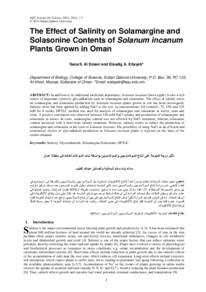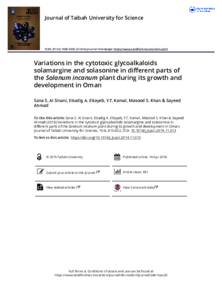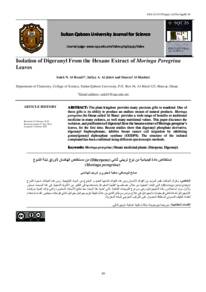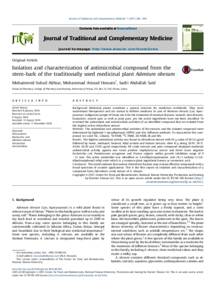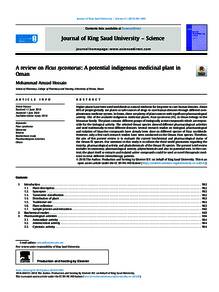Document
The effect of salinity on solamargine and solasonine contents of solanum incanum plants grown in Oman.
Identifier
https://doi.org/10.24200/squjs.vol19iss2pp1-7
Source
Sultan Qaboos University Journal for Science. v. 19, no. 2, p. 1-7.
Contributors
Eltayeb, Elsadig A. , Author
Country
Oman.
City
Muscat.
Publisher
College of Science, Sultan Qaboos University.
Gregorian
2015-02-01
Language
English
English abstract
In addition to its traditional medicinal importance, Solanum incanum (thorn apple) is also a rich source of important cytotoxic glycoalkaloids such as solamargine and solasonine. The effect of salinity stress on solamargine and solasonine production by Solanum incanum plants grown in soil has been investigated. Salinity stress has been applied by adding NaCl to the soil, in concentrations: 0.0 (control), 75, 150, and 225 mM for 8 weeks. HPTLC method was used for analysis of solamargine and solasonine in leaves, stem and roots. A positive correlation was observed between 150 mM NaCl salinity and production of solamargine and solasonine in leaves. In roots, solamargine content was not affected by NaCl treatment, whereas solasonine content increased with a short-term salinity treatment. However, salinity seems to reduce the production of solamargine and solasonine in the roots of Solanum incanum. The possibility of using NaCl as an efficient and economical elicitor of glycoalkaloid production in Solanum incanum plants is rejected on the basis of the results obtained.
ISSN
2414-536 X
Arabic abstract
بالإضافة إلى أهميته الطبية التقليدية، يُعدّ نبات السولانوم إنكانوم (التفاح الشوكي) مصدرًا غنيًا للجليكوألكالويدات السامة للخلايا، مثل السولامارجين والسولاسونين. وقد دُرِسَ تأثير الإجهاد الملحي على إنتاج السولامارجين والسولاسونين في نباتات السولانوم إنكانوم المزروعة في التربة. وقد طُبِّقَ الإجهاد الملحي بإضافة كلوريد الصوديوم إلى التربة، بتركيزات: 0.0 (مجموعة التحكم)، و75، و150، و225 ملي مولار لمدة 8 أسابيع. واستُخدمت طريقة HPTLC لتحليل السولامارجين والسولاسونين في الأوراق والساق والجذور. ولوحظ وجود علاقة إيجابية بين ملوحة كلوريد الصوديوم البالغة 150 ملي مولار وإنتاج السولامارجين والسولاسونين في الأوراق. أما في الجذور، فلم يتأثر محتوى السولامارجين بمعالجة كلوريد الصوديوم، بينما ازداد محتوى السولاسونين مع معالجة ملوحة قصيرة الأمد. مع ذلك، يبدو أن الملوحة تُقلل من إنتاج السولامارجين والسولاسونين في جذور نبات السولانوم إنكانوم. وبناءً على النتائج المُحصّلة، رُفضت إمكانية استخدام كلوريد الصوديوم كمُحفّز فعّال واقتصادي لإنتاج الجليكوألكالويد في نباتات السولانوم إنكانوم.
Category
Journal articles

